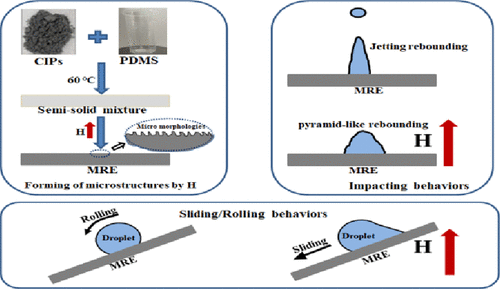Our official English website, www.x-mol.net, welcomes your
feedback! (Note: you will need to create a separate account there.)
Magnetic-Responsive Superhydrophobic Surface of Magnetorheological Elastomers Mimicking from Lotus Leaves to Rose Petals
Langmuir ( IF 3.7 ) Pub Date : 2021-02-05 , DOI: 10.1021/acs.langmuir.0c03122 Shiwei Chen 1, 2 , Minghui Zhu 1 , Yuanhao Zhang 1 , Shuai Dong 2 , Xiaojie Wang 2
Langmuir ( IF 3.7 ) Pub Date : 2021-02-05 , DOI: 10.1021/acs.langmuir.0c03122 Shiwei Chen 1, 2 , Minghui Zhu 1 , Yuanhao Zhang 1 , Shuai Dong 2 , Xiaojie Wang 2
Affiliation

|
In nature, many plants have evolved various wettability surfaces to survive and thrive in diverse environments. For example, the superhydrophobic surface of lotus can keep itself clean, while the rose petals can retain droplets for a long time. The former is referred to the “lotus effect,” and the latter is known as the “rose petal effect.” This research proposes a method to fabricate magnetic-responsive superhydrophobic magnetorheological elastomers (MREs) which could reversibly and instantly transition their surface wetting state between the “lotus effect” and the “rose petal effect.” These surfaces with controllable wettability could find applications in the manipulation of liquids in biological and chemical systems. The MREs are cured by applying a uniform magnetic field to form “mountain-like” microstructures on their surfaces. This initial surface is rough and exhibits the lotus leaf effect. Because of the nonuniform magnetically induced deformation, the surface micromorphology and roughness can be altered by an applied magnetic field. The state of water droplets on its surface is changed from the Wenzel state to the Cassie-Baxter (CB) state. Therefore, the proposed MRE surface could switch their dynamic wetting features between the “rose petals” and “lotus leaves” via a magnetic field. An experimental platform for the wetting features of MRE surfaces is established to characterize the dynamic behaviors of water drops on MREs under a magnetic field. A magneto-mechanic coupled model is proposed to interpret how the magnetic field influences the MRE surface as well as the droplet movement.
中文翻译:

从荷叶到玫瑰花瓣的磁流变弹性体的磁响应超疏水表面
在自然界中,许多植物已经进化出各种可湿性表面,以在各种环境中生存和繁衍。例如,莲花的超疏水表面可以保持自身清洁,而玫瑰花瓣可以长时间保留水滴。前者称为“莲花效应”,后者称为“玫瑰花瓣效应”。这项研究提出了一种制造磁响应性超疏水磁流变弹性体(MRE)的方法,该方法可以可逆地立即在“莲花效应”和“玫瑰花瓣效应”之间转变其表面润湿状态。这些具有可控润湿性的表面可以在生物和化学系统中的液体处理中找到应用。通过施加均匀的磁场使MRE固化,以在其表面形成“山样”微结构。该初始表面是粗糙的并且表现出荷叶效果。由于不均匀的磁感应变形,所施加的磁场会改变表面的微观形态和粗糙度。其表面上的水滴状态从Wenzel状态更改为Cassie-Baxter(CB)状态。因此,建议的MRE表面可以通过磁场在“玫瑰花瓣”和“荷叶”之间切换其动态润湿特性。建立了用于MRE表面润湿特征的实验平台,以表征磁场下MRE上水滴的动态行为。提出了一种磁力耦合模型来解释磁场如何影响MRE表面以及液滴运动。由于不均匀的磁感应变形,所施加的磁场会改变表面的微观形态和粗糙度。其表面上的水滴状态从Wenzel状态更改为Cassie-Baxter(CB)状态。因此,建议的MRE表面可以通过磁场在“玫瑰花瓣”和“荷叶”之间切换其动态润湿特性。建立了用于MRE表面润湿特征的实验平台,以表征磁场下MRE上水滴的动态行为。提出了一种磁力耦合模型来解释磁场如何影响MRE表面以及液滴运动。由于不均匀的磁感应变形,所施加的磁场会改变表面的微观形态和粗糙度。其表面上的水滴状态从Wenzel状态更改为Cassie-Baxter(CB)状态。因此,建议的MRE表面可以通过磁场在“玫瑰花瓣”和“荷叶”之间切换其动态润湿特性。建立了用于MRE表面润湿特征的实验平台,以表征磁场下MRE上水滴的动态行为。提出了一种磁力耦合模型来解释磁场如何影响MRE表面以及液滴运动。其表面上的水滴状态从Wenzel状态更改为Cassie-Baxter(CB)状态。因此,建议的MRE表面可以通过磁场在“玫瑰花瓣”和“荷叶”之间切换其动态润湿特性。建立了用于MRE表面润湿特征的实验平台,以表征磁场下MRE上水滴的动态行为。提出了一种磁力耦合模型来解释磁场如何影响MRE表面以及液滴运动。其表面上的水滴状态从Wenzel状态更改为Cassie-Baxter(CB)状态。因此,建议的MRE表面可以通过磁场在“玫瑰花瓣”和“荷叶”之间切换其动态润湿特性。建立了用于MRE表面润湿特征的实验平台,以表征磁场下MRE上水滴的动态行为。提出了一种磁力耦合模型来解释磁场如何影响MRE表面以及液滴运动。建立了用于MRE表面润湿特征的实验平台,以表征磁场下MRE上水滴的动态行为。提出了一种磁力耦合模型来解释磁场如何影响MRE表面以及液滴运动。建立了用于MRE表面润湿特征的实验平台,以表征磁场下MRE上水滴的动态行为。提出了一种磁力耦合模型来解释磁场如何影响MRE表面以及液滴运动。
更新日期:2021-02-23
中文翻译:

从荷叶到玫瑰花瓣的磁流变弹性体的磁响应超疏水表面
在自然界中,许多植物已经进化出各种可湿性表面,以在各种环境中生存和繁衍。例如,莲花的超疏水表面可以保持自身清洁,而玫瑰花瓣可以长时间保留水滴。前者称为“莲花效应”,后者称为“玫瑰花瓣效应”。这项研究提出了一种制造磁响应性超疏水磁流变弹性体(MRE)的方法,该方法可以可逆地立即在“莲花效应”和“玫瑰花瓣效应”之间转变其表面润湿状态。这些具有可控润湿性的表面可以在生物和化学系统中的液体处理中找到应用。通过施加均匀的磁场使MRE固化,以在其表面形成“山样”微结构。该初始表面是粗糙的并且表现出荷叶效果。由于不均匀的磁感应变形,所施加的磁场会改变表面的微观形态和粗糙度。其表面上的水滴状态从Wenzel状态更改为Cassie-Baxter(CB)状态。因此,建议的MRE表面可以通过磁场在“玫瑰花瓣”和“荷叶”之间切换其动态润湿特性。建立了用于MRE表面润湿特征的实验平台,以表征磁场下MRE上水滴的动态行为。提出了一种磁力耦合模型来解释磁场如何影响MRE表面以及液滴运动。由于不均匀的磁感应变形,所施加的磁场会改变表面的微观形态和粗糙度。其表面上的水滴状态从Wenzel状态更改为Cassie-Baxter(CB)状态。因此,建议的MRE表面可以通过磁场在“玫瑰花瓣”和“荷叶”之间切换其动态润湿特性。建立了用于MRE表面润湿特征的实验平台,以表征磁场下MRE上水滴的动态行为。提出了一种磁力耦合模型来解释磁场如何影响MRE表面以及液滴运动。由于不均匀的磁感应变形,所施加的磁场会改变表面的微观形态和粗糙度。其表面上的水滴状态从Wenzel状态更改为Cassie-Baxter(CB)状态。因此,建议的MRE表面可以通过磁场在“玫瑰花瓣”和“荷叶”之间切换其动态润湿特性。建立了用于MRE表面润湿特征的实验平台,以表征磁场下MRE上水滴的动态行为。提出了一种磁力耦合模型来解释磁场如何影响MRE表面以及液滴运动。其表面上的水滴状态从Wenzel状态更改为Cassie-Baxter(CB)状态。因此,建议的MRE表面可以通过磁场在“玫瑰花瓣”和“荷叶”之间切换其动态润湿特性。建立了用于MRE表面润湿特征的实验平台,以表征磁场下MRE上水滴的动态行为。提出了一种磁力耦合模型来解释磁场如何影响MRE表面以及液滴运动。其表面上的水滴状态从Wenzel状态更改为Cassie-Baxter(CB)状态。因此,建议的MRE表面可以通过磁场在“玫瑰花瓣”和“荷叶”之间切换其动态润湿特性。建立了用于MRE表面润湿特征的实验平台,以表征磁场下MRE上水滴的动态行为。提出了一种磁力耦合模型来解释磁场如何影响MRE表面以及液滴运动。建立了用于MRE表面润湿特征的实验平台,以表征磁场下MRE上水滴的动态行为。提出了一种磁力耦合模型来解释磁场如何影响MRE表面以及液滴运动。建立了用于MRE表面润湿特征的实验平台,以表征磁场下MRE上水滴的动态行为。提出了一种磁力耦合模型来解释磁场如何影响MRE表面以及液滴运动。











































 京公网安备 11010802027423号
京公网安备 11010802027423号